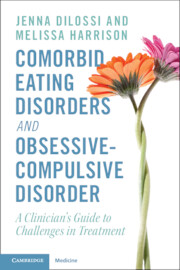 Comorbid Eating Disorders and Obsessive-Compulsive Disorder
Comorbid Eating Disorders and Obsessive-Compulsive Disorder Book contents
- Comorbid Eating Disorders and Obsessive-Compulsive Disorder
- Comorbid Eating Disorders and Obsessive-Compulsive Disorder
- Copyright page
- Contents
- Foreword
- Preface
- Acknowledgments
- Abbreviations
- Part I Overview of the Existing Literature
- Part II Clinical Pitfalls and Treatment Failures
- Chapter 7 Underweight and Malnourished Patients
- Chapter 8 Provider Collaboration in Eating Disorder Treatment
- Chapter 9 Impact of Eating Disorder Treatment on Obsessive-Compulsive Symptoms
- Chapter 10 The Relationship between Eating, Distress Tolerance, and Emotion Regulation in Obsessive-Compulsive Disorder
- Chapter 11 Poorly Executed Exposures
- Chapter 12 Considerations for Exposure Therapy in Eating Disorder Treatment
- Chapter 13 Subclinical Features as Treatment Barriers
- Part III Evidence-Informed Considerations for Assessment and Treatment
- Part IV Special Topics and Future Considerations
- References
- Index
Chapter 11 - Poorly Executed Exposures
from Part II - Clinical Pitfalls and Treatment Failures
Published online by Cambridge University Press: 14 December 2023
- Comorbid Eating Disorders and Obsessive-Compulsive Disorder
- Comorbid Eating Disorders and Obsessive-Compulsive Disorder
- Copyright page
- Contents
- Foreword
- Preface
- Acknowledgments
- Abbreviations
- Part I Overview of the Existing Literature
- Part II Clinical Pitfalls and Treatment Failures
- Chapter 7 Underweight and Malnourished Patients
- Chapter 8 Provider Collaboration in Eating Disorder Treatment
- Chapter 9 Impact of Eating Disorder Treatment on Obsessive-Compulsive Symptoms
- Chapter 10 The Relationship between Eating, Distress Tolerance, and Emotion Regulation in Obsessive-Compulsive Disorder
- Chapter 11 Poorly Executed Exposures
- Chapter 12 Considerations for Exposure Therapy in Eating Disorder Treatment
- Chapter 13 Subclinical Features as Treatment Barriers
- Part III Evidence-Informed Considerations for Assessment and Treatment
- Part IV Special Topics and Future Considerations
- References
- Index
Summary
Exposure therapy is widely recognized as an effective psychological treatment for OCD but it is not successful in every case. Poorly executed exposure techniques could be implicated. Negative perceptions contribute to poor execution, pitfalls, or the underutilization of this therapy altogether. This, along with common ED misconceptions that are cultural and disorder-specific, can also result in poor treatment for those with EDs. It is important that the therapist has a thorough understanding of the patient’s presentation to ensure that exposures target the precise core fear for new learning. Lack of understanding can lead to mistakes and missed opportunities to enhance exposure, such as failing to explain the rationale, reducing safety behaviors, or overusing a hierarchy. An inexperienced therapist may not understand the importance of discussing the role of family and friends and how their accommodation can perpetuate symptoms, hindering new learning and preventing lasting change. The therapist should be able to identify the core fear, triggers, and avoidance behaviors in the patient and use strategies to enhance inhibitory learning and maximize the chances of successful treatment.
Keywords
- Type
- Chapter
- Information
- Comorbid Eating Disorders and Obsessive-Compulsive DisorderA Clinician's Guide to Challenges in Treatment, pp. 71 - 77Publisher: Cambridge University PressPrint publication year: 2023
